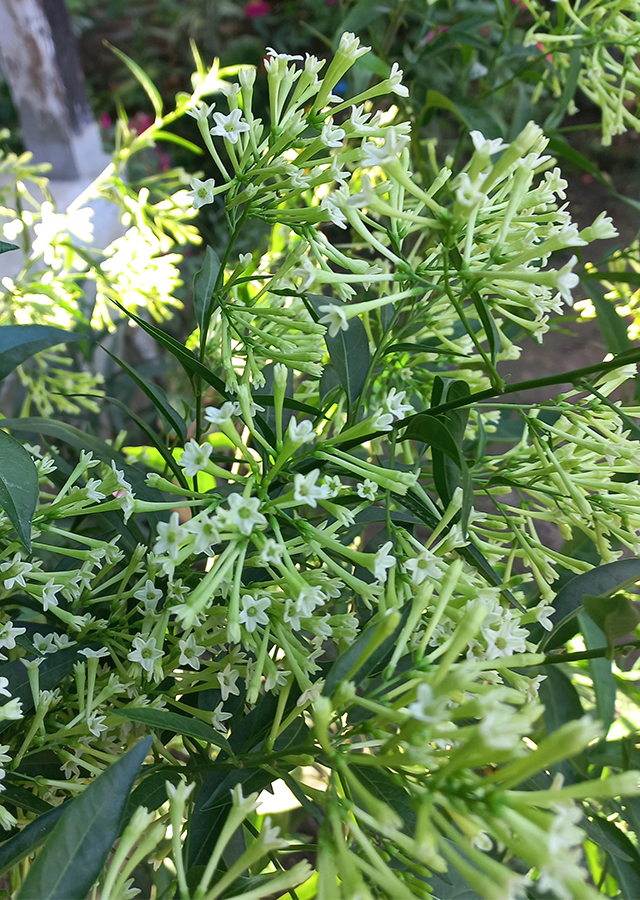Traditional Herbs from Cestrum nocturnum
overcoming_skin_eruption
- Take enough fresh dalu arum leaves, wash them until clean.
- Boil the leaves\u00a0until they boil.
- Crush them until they become a paste.
- Apply the paste to the skin.
cure_burns_and_swelling":[ "Prepare enough fresh dalu arum leaves, wash them until clean.
What is Cestrum nocturnum Looks like??



Parts of Cestrum nocturnum that could be used
- Leaves
- Flowers
- Fruits
Cestrum nocturnum Distribution
Arum dalu is a plant from the Solanaceae family and is thought to be native to the Antilles and Central America, but is now widespread throughout the tropical regions of the Old and New Worlds and is known to be invasive to many places including Hawaii, the Cook Islands, Fiji, French Polynesia, Western Samoa , Tonga, New Caledonia and New Zealand. This species has also been widely cultivated in tropical and subtropical areas, including throughout Southeast Asia. Where this species is popularly grown as an ornamental plant, due to its striking white flowers and sweet aroma that bloom at night. This species is also widely used in religious rituals. Where the flowers are used as offerings to Shiva and Ganesha in Kathmandu while in Napal, the leaves and flowers are used as ritual incense and fresh flowers are eaten and fried flowers are smoked for spiritual healing energy. Apart from that, this species can also be used as a perfume, mosquito repellent, hedge plant, and medicinal plant. As a medicinal plant, traditionally arum dalu is widely used as a medicine for eczema. And the leaves have been proven to have antimicrobial, analgesic and anti-inflammatory activity.Agroecology of Cestrum nocturnum
Arum dalu is generally found at low to medium altitudes. In Southeast Asia, this species is cultivated and naturalized locally from sea level to an altitude of 1,600 m above sea level. In Nicaragua, this species grows at altitudes between 40 - 1,000 m above sea level. Arum dalu grows well in damp or wet forests including areas along rivers, secondary forests, dense lowland forests, bushes, open areas, both natural and disturbed. It prefers light sandy soil and is adaptable to a variety of soil types and conditions, but has a low salt and waterlogging tolerance. Grows well in full sun but can tolerate light shade.
Morphology of Cestrum nocturnum
- Stems are woody, light green, much branched, spreading, sometimes curved. Young stems are pilose, with simple spreading multicellular eglandular hairs, then glabrous.
- Leaves are simple, alternate (alternate), lanceolate-elliptical, surface shiny leaves, leaf tips pointed (acute) to tapered (acuminate), base rounded or pointed, edges flat, light to dark green, both surfaces glabrous.
- Bisexual flowers and Fragrant. Has a greenish-white-greenish-yellow crown, tubular and slender, slightly enlarged towards the top, glabrous on the outside and inside, 5 petals (corolla) and narrow triangular lobes, usually spread out after the flower opens, very sweet scented. . Campanulate calyx (bell-like), upper 1/3 divided into triangular lobes, 5 stamens, anthers emerge, filaments attached to the corolla tube, upper part free, with 2 teeth at the base of the free part, anther. brown. The ovaries or ovaries are green, round or ovoid, glabrous, greenish-white discs. The inflorescence is an axillary or terminal cyme 3-8 cm long. fruit, oval, prismatic, outer face convex, inner face concave, reticulate, black.
Cultivation of Cestrum nocturnum
Plant propagation is generative (seeds) and vegetative (stem cuttings).
Cestrum nocturnum, more details :
Chemical Content of Cestrum nocturnumFlavonoids, steroidal saponins (nocturnoside A, tigogenin, smilagenin, and yuccagenin), tannins, monoterpenes, sesquiterpenes, triterpenes, sterols, coumarins, cardiac glycosides, essential oils (ß-phellandrene, a-phellandrene, (E)-ß-ocimene, linalool), alkaloids (nicotine and nornicotine), ethyl citrate, phytol, 4-isobutylmorphine, n-hexadecanoic acid.
Benefits of Cestrum nocturnum
Treats epilepsy, cataracts, wounds and swelling, malaria, diarrhea, treats skin eruptions (as lotion), softens the skin, treats eczema, external application to help heal burns and swelling. Has antimicrobial, analgesic, antioxidant and anti-inflammatory activity.
Simplisia of Cestrum nocturnum
- Prepare enough fresh arum dalu leaves, wash thoroughly with running water then drain." Store\u00a0simplicia in plastic or a clean, airtight container.
Another Facts for Cestrum nocturnum :
Synonym of Cestrum nocturnumCestrum graciliflorum Dunal, Cestrum spicatum Mill., Cestrum suberosum Jacq.
Habitus of Cestrum nocturnum
Bush. Annual shrub, capable of growing up to 4 m high
Habitat of Cestrum nocturnum
- Riverside", "Coastal", "Roadside", "Land
No comments:
Post a Comment